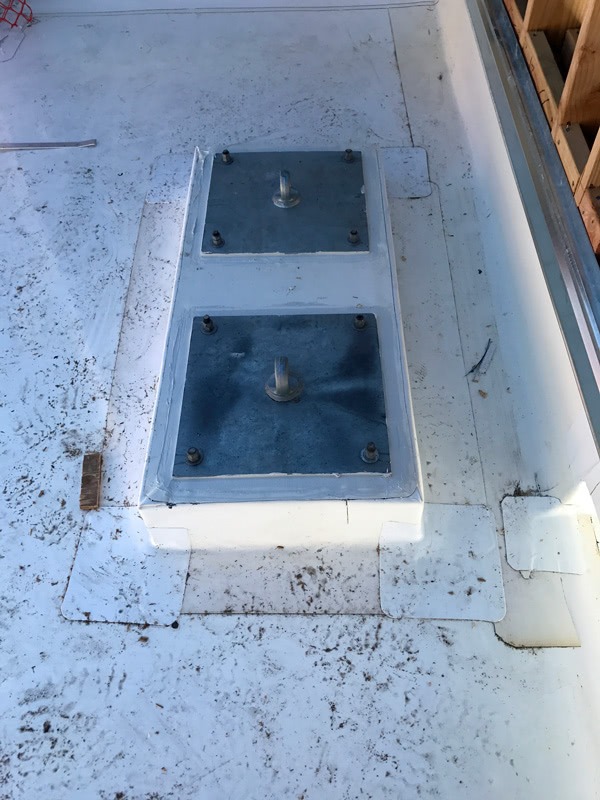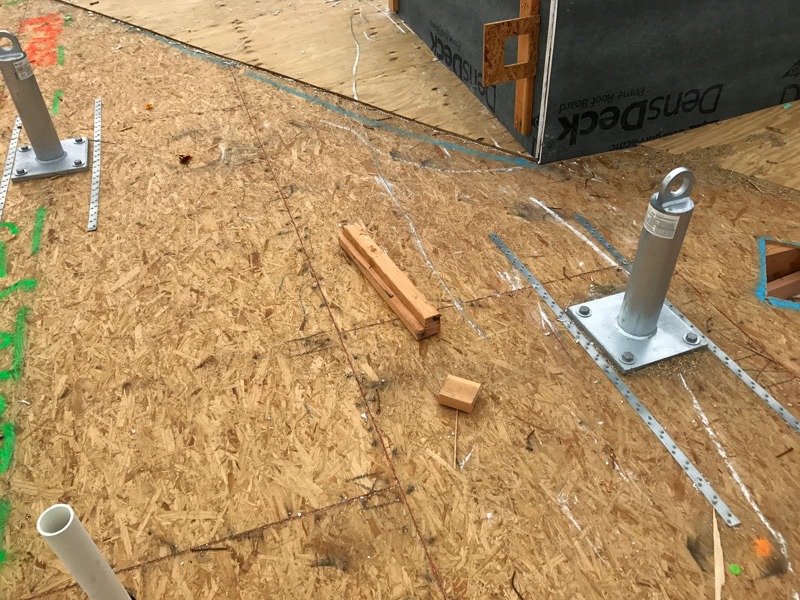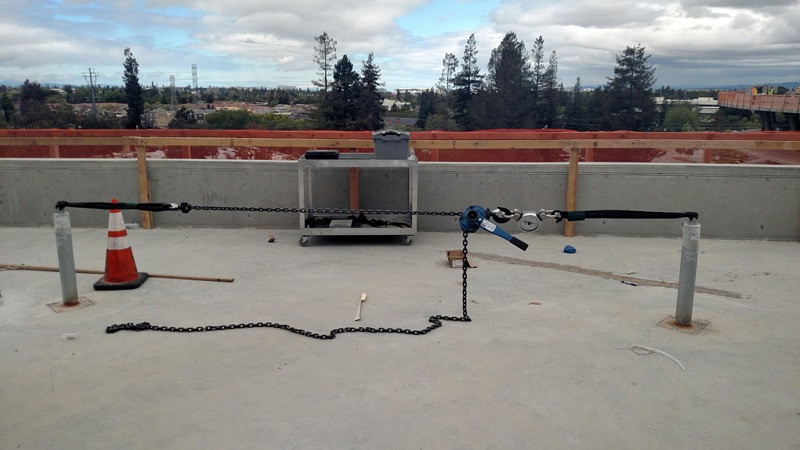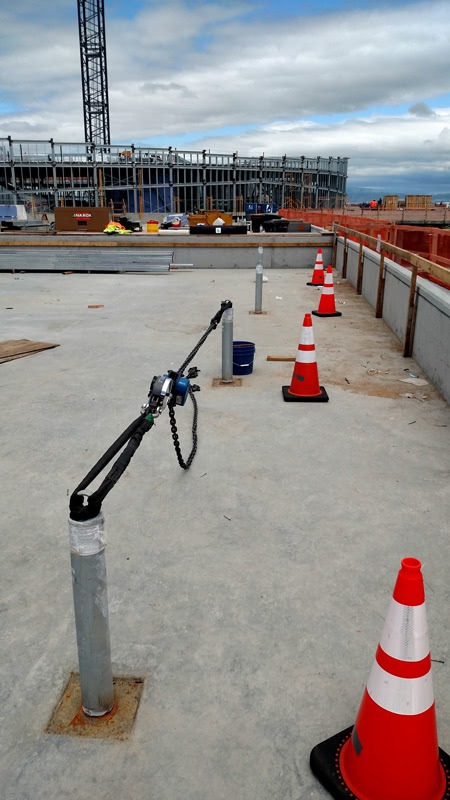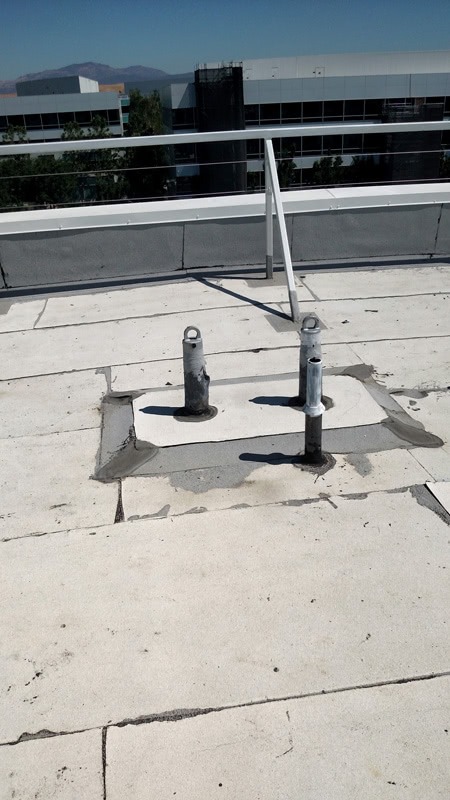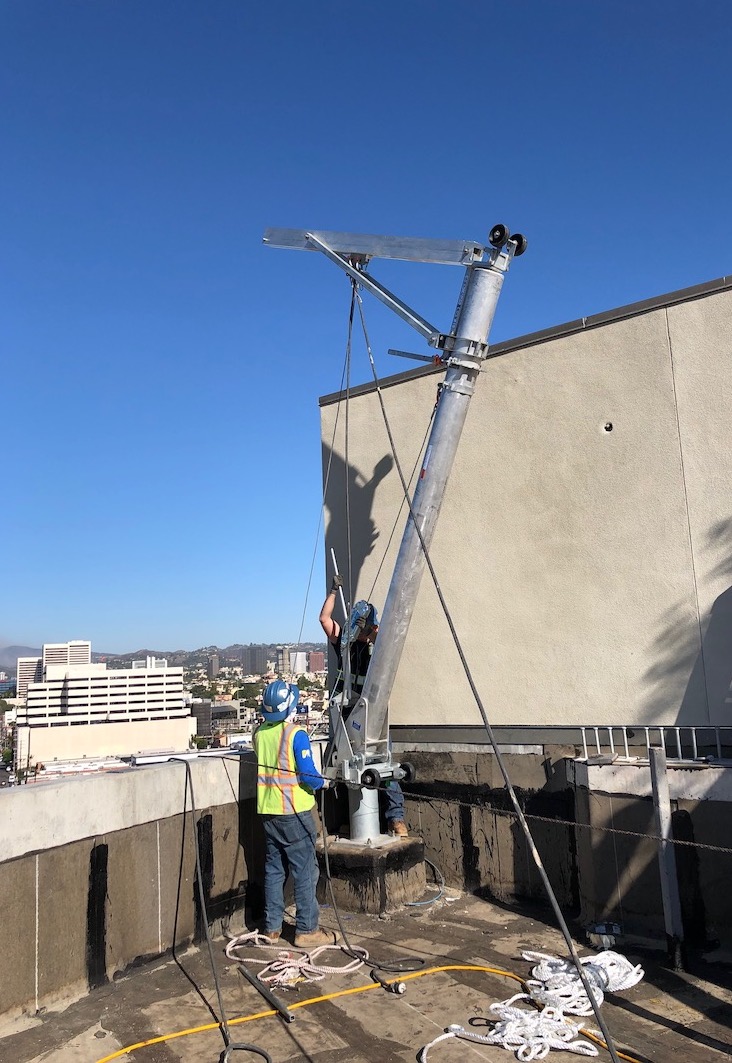Roof davits and tie-back anchors are used during exterior building maintenance to the exterior façade of a structure, such as window washing, caulking and painting. These anchors are capable of withstanding an ultimate load of 5,000 lbs in any direction per Cal/OSHA Title 8, 3291 to allow for the suspension of scaffolds or Bosun chairs.
Our roof davits are trusted by building owners throughout California. We guide you through every step of the process from initial consultation to engineering and installation, all while ensuring you have the proper test documentation per Cal/OSHA Title 8 requirements.
Request A Quote
F.A.Q.
When are roof davits required?
Buildings 36’ tall or 3 stories are required to have roof davits (tie-backs) unless you can achieve window washing and unscheduled maintenance from ground-based equipment. At 48’ or 4 stories, you must provide them regardless of ground-based equipment capability.
At minimum, they must be installed at intervals of 12’ on center around the building for unscheduled maintenance, and if used for window washing, must be specifically designed to accommodate the particular window washing activities.
Do we need an OPOS (operation procedure outline sheet)?
How often do roof davits (tie-back anchors) need to be inspected and re-certified?
Each roof davit installation shall undergo a periodic inspection and test at least every 12 months by the equipment manufacturer, authorized representative, or other qualified person acceptable to the Division. All parts of the equipment, including related building support structures, shall be inspected, and where necessary, tested to determine to be in safe operating condition.
Are roof davits the same as fall protection anchors?
No. Roof davits are designed to have the capability of suspending scaffolding or personnel from the anchor to safely work on the face of a building. Rooftop fall protection anchors are designed to protect a worker from falling off the building.
Fall protection anchors are typically much smaller and have far less strength requirement. Roof davits must be capable of 5,000lbs in any direction while fall protection anchors must have an ultimate strength of 5,000lbs or meet a safety factor of two as a complete fall protection system.
Are roof anchors the same as roof davits?
Yes. Roof davits are sometimes also referred to as roof anchors, tie-back anchors, tiedowns, tie-offs, anchor rings, roof posts, 5,000lb anchors, and scaffold anchors.
Roof Davits and/or Tieback Anchors
When your commercial building requires cleaning, repairs, or maintenance, it’s your responsibility to ensure the workers stay safe. Roof davits, and/or tie-back anchors, are an important safety feature for construction or maintenance workers working on the exterior of any tall building.
Roof davits / tie-back anchors are used during maintenance to the external face of a building, such as window washing and painting. These anchors are capable of withstanding an ultimate load of 5,000 lbs in any direction per Cal/OSHA Title 8, 3291 to allow for the suspension of scaffolds or Bosun chairs.
Safety is the number one priority for workers performing above-ground operations. When workers step onto a suspended platform, it’s vital that safety systems work properly. Roof davits aren’t simply a good idea for these workers, they’re required by Cal/OSHA.
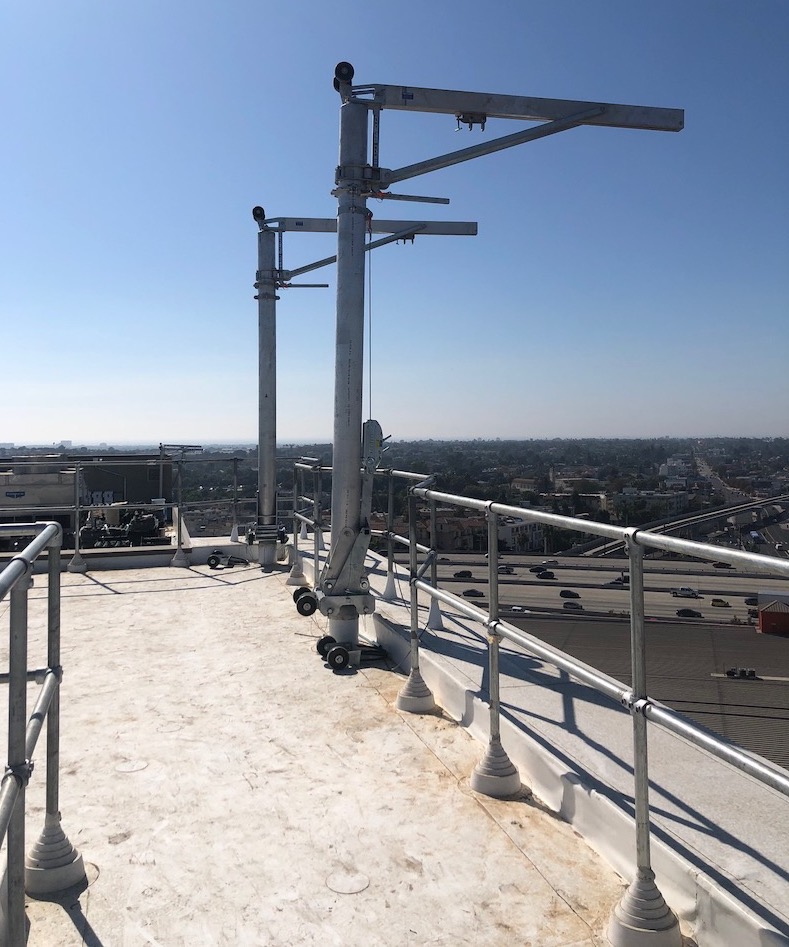
Most people don’t know much about roof davits, and that’s okay. Our experts know all the important details so the local employees who spend their days toiling above ground can get the job done right and get safely back on solid ground. Here are the essentials, in case you’d like to learn more.
Most Common Roof Davits
Fall protection isn’t a one-size-fits-all product. Therefore, there are several types of roof davits available to fit the requirements and restrictions of the job at hand. The most commonly used types of roof davits are below.
Material Lifting
Every job requires tools and supplies which are often heavy and bulky. Material lifting davits are designed to carry supplies needed to complete a job up or down the building facade.
Personnel Lifting
Designed to carry people who are making repairs or maintaining the outside of a building. They may be used for transport to and from the roof or work on the side of the building, like window replacement.
Motor-Powered
The use of a motor allows these davits to offer greater control for the transport of heavy, bulky items. They’re often used during construction or major repairs to carry things like HVAC systems and equipment for maintenance.
Hand-Powered
While hand powered davits offer less control, they have their own advantages. They are easy to assemble and take apart, making them perfect for quick and/or light lifting jobs.
Ground-Rigged
Designed to provide lifting capability for jobs that don’t require work above the third floor, ground-rigged davits ascend from the ground rather than descend from the roof. They require less space than davits that are rigged from the roof.
Roof-Rigged
These davits require more roof space and have longer and taller arms than ground davits. This allows them to handle sizable platforms and work well with a variety of building types.
Fall Protection You Can Count On
We handle every detail of fall protection from start to finish including engineering, design, fabrication, installation, and training. Safety is not an area where you can assume things are done right. Our expert team members are certified installers of 3M Fall Protection, XS Platforms Lifeline Systems, and multiple other recognized brands. We’re trained by the manufacturers of these products, so you know your system will be properly installed.
Without the right fall protection equipment, lives are at stake. We understand that workers are often under tight schedules. That’s why we’re prepared to mobilize immediately to provide your workers with safe working space within your deadlines, working to your schedule to provide Cal/OSHA-compliant fall protection.
Contact us today if you’re in need of a davit system, roof guardrails, skylight protection, rigid rail overhead fall protection system, or other fall safety equipment. We’re the fall protection pros with the expert customer service you can count on.
Window Washing Davits
No matter if you’re painting, doing maintenance, giving it a full window cleaning, or just running some check-up maintenance, roof davit systems will be your go-to tool.
Considering the potential danger of hanging off the side of a building, window washing davits must uphold a whole host of OSHA guidelines. This makes them an accessible, stable, and safe way of allowing workers to reach the outside of your buildings.
Let’s take a look at these fantastic fall protection tools in more detail.
What Exactly Are Window Washing Davits?
While davits come in many forms, particularly ground rigged and roof rigged, the majority of window washing davits will be roof rigged. This allows washers to begin at the highest floor and continuously work their way down.
When moving down a building, the davit system will hold the weight of the platform held by horizontal lifelines, allowing workers to quickly and safely transverse the exterior of the building.
What Are the Benefits of Davits?
Once the base is installed on the building, you’ll be able to attach and detach the arms. Not only does this mean the davits systems are easy to move, but they also won’t take away from the natural beauty of a building. Much more secure than a roof anchor or tieback anchor, a davit system is a permanent structure that is securely mounted on top of a building to hold a suspended scaffold.
But that’s not everything; window washing davits also have the following benefits:
Can be permanently set up for easy routine cleaning
Allow workers to access the outside of a building or facade access
Provide a safe way of maneuvering the outside of buildings
OSHA regulations make them incredibly stable and secure
What OSHA Regulations Apply to Window Washing Davits?
What’s more, OSHA writes clauses into their regulations that specify that davits must undergo rigorous testing and inspections, further putting your mind at ease.
At Diversified Fall Protection, all of our window washing davit systems and facade access equipment uphold all OSHA and ANSI regulations, ensuring the total safety of your workers. Our series of PEAK anchors are adaptable, allowing you to find the correct fall protection system for your building.
If you need an all-in-one fall protection solution, we’ll be able to give you a quote. Simply reach out and get the very best help – today!

